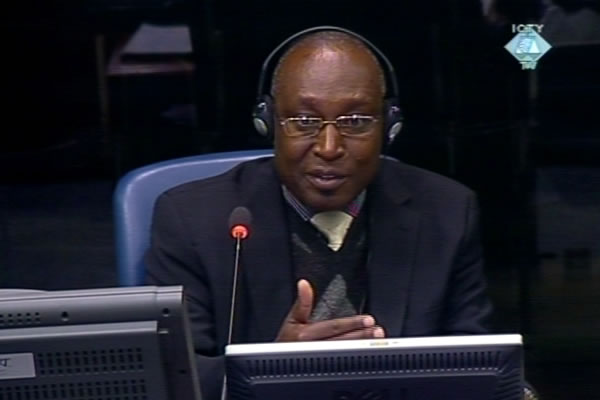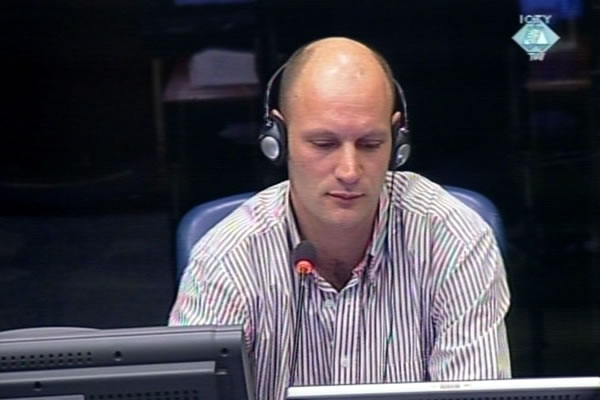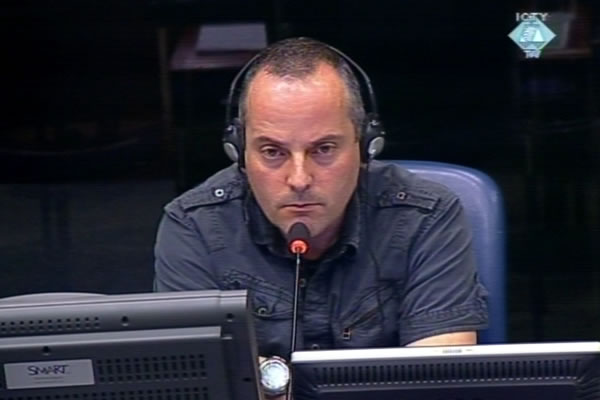Home
KARADZIC 'WATCHED PANDUREVIC'S BACK'
Radovan Karadzic contends that the men who were separated from the women and children by the Serb forces in Potocari and detained in the ‘white house’ were prisoners of war. Karadzic also said that the people left the Srebrenica enclave ‘voluntarily’ on the ‘orders’ of the Muslim authorities. In Karadzic’s words, he personally ‘guarded [Pandurevic's] back' when he decided to open the corridor allowing the column of soldiers and civilians to pass through towards Tuzla on 16 July 1995. The witnesses mostly disagreed with Karadzic’s claims
 Josef Kingori, witness at the Radovan Karadzic trial
Josef Kingori, witness at the Radovan Karadzic trial Radovan Karadzic continued the cross-examination of Kenyan colonel Josef Kingori today. The witness disagreed with Karadzic’s claim that the men separated from the women and children by the VRS soldiers after the fall of Srebrenica and detained in the ‘white house’ were prisoners of war.
According to Kingori, the men detained in the ‘white house’ in Potocari were civilians separated from their families by the Serb forces. The Serb troops took away their personal possessions and documents and held them captive in the ‘white house’. Later, the Serb soldiers threatened them with weapons, forced them to get on the buses and took them away.
The witness said that the men in the ‘white house’ were crammed in like ‘sardines’. Among them were boys younger than 16 and their faces showed that they didn’t know anything about the war. The witness managed to separate some boys who were close to him from the other men. ‘I was only able to save a few of them’, the witness recounted.
Karadzic told the witness that he, Karadzic, personally ‘guarded [Pandurevic's] back' when he decided on 16 July 1995 to open a corridor and allow the column of Muslim soldiers and civilians pass through towards Tuzla. As Kingori noted, this was certainly in the interest of the Serb side, because the Serbs wanted the population to leave the enclave. ‘Just as you provided buses for the men in Potocari, your only concern was how to get rid of them’, the witness added.
After Josef Kingori completed his evidence, the prosecution called Paul Groenewegen. In the summer of 1995, Groenewegen served in the UN Dutch Battalion in the Srebrenica enclave. Groenewegen’s written statement based on his previous evidence at the trials of Blagojevic, Popovic and Tolimir was admitted into evidence.
Groenewegen saw when the men were separated from the women and children after the Serb troops entered Potocari on 12 July 1995. This continued on 13 July 1995 when the witness saw three Serb soldiers take a man out from the ‘white house’. They put the man to the house wall and shot him in the head from the distance of three meters.
In the cross-examination Karadzic claimed that the ‘Muslim authorities ordered’ the population to go to Potocari and the army to head toward Tuzla. Karadzic also put it to the witness that the people from Srebrenica went to Potocari ‘voluntarily’ and again left Potocari ‘voluntarily’ to go to the territory controlled by the BH Army. The witness dismissed Karadzic’s claims.
The prosecution then called Roger Patelski, another former member of the Dutch Battalion. In his statement to the OTP investigators, admitted into evidence today, Patelski said that the men evacuated from Potocari by bus ‘had the look of death in their eyes, as if they thought they wouldn’t survive that day’.
Roger Patelski will continue his evidence on Monday, 16 January 2012.
Photos
Linked Reports
- Case : Karadzic
- 2012-01-12 WITNESS: SERB OFFICERS TOLD US THEY WANTED SREBRENICA FOR THEMSELVES
- 2012-01-11 KARADZIC DENIES MASS EXECUTIONS
- 2012-01-10 SURVIVOR FROM PETKOVCI DAM GIVES EVIDENCE
- 2012-01-16 SREBRENICA WAS CAPTURED ‘RAMBO STYLE’
- 2012-01-17 KARADZIC: ‘SERBS PROVED THEIR NOBILITY’ IN SREBRENICA
- 2012-01-18 WHO’S RESPONSIBLE FOR THE BAD IMAGE OF KARADZIC’S TROOPS IN WESTERN MEDIA?


